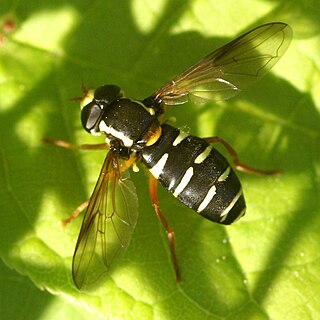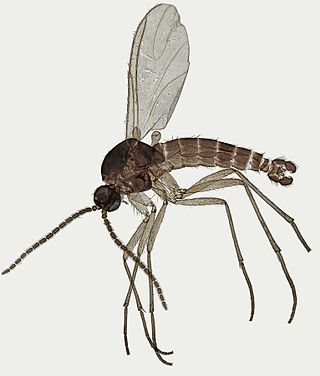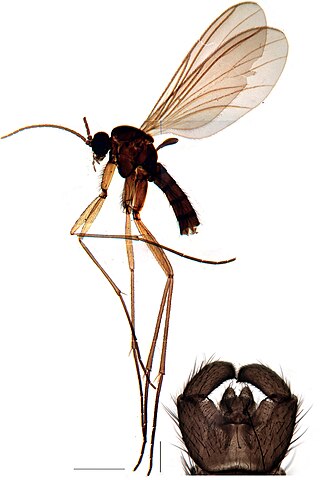
Casuarina, also known as she-oak, Australian pine and native pine, is a genus of flowering plants in the family Casuarinaceae, and is native to Australia, the Indian subcontinent, Southeast Asia, islands of the western Pacific Ocean, and eastern Africa.

The Nematocera are a suborder of elongated flies with thin, segmented antennae and mostly aquatic larvae. This group is paraphyletic and contains all flies but species from suborder Brachycera, which includes more commonly known species such as the housefly or the common fruit fly. The equivalent clade to Nematocera is the whole Diptera, with Brachycera as a subclade. Families in Nematocera include mosquitoes, crane flies, gnats, black flies, and multiple families commonly known as midges. The Nematocera typically have fairly long, fine, finely-jointed antennae. In many species, such as most mosquitoes, the female antennae are more or less threadlike, but the males have spectacularly plumose antennae.

The Tephritoidea are a superfamily of flies. It has over 7,800 species, the majority of them in family Tephritidae.

The Sciaridae are a family of flies, commonly known as dark-winged fungus gnats. Commonly found in moist environments, they are known to be a pest of mushroom farms and are commonly found in household plant pots. This is one of the least studied of the large Diptera families, probably due to the small size of these insects and the similarity among species.

Sciaroidea is a superfamily in the infraorder Bibionomorpha. There are about 16 families and more than 15,000 described species in Sciaroidea. Most of its constituent families are various gnats.

The Diadocidiidae are a family of flies (Diptera), containing one extant genus with over 20 species and one extinct genus. Diadocidiidae are found worldwide, except in Africa and Antarctica. They are usually considered close to the Keroplatidae, Bolitophilidae, and Ditomyiidae, and used to be included in the Mycetophilidae. They are woodland flies, found in shaded places in forests or near streams. The larvae spin silken tubes under bark or in dead logs, and feed on hymenium of Polyporaceae fungi. The average body length for adults is around 2.5–5.6 mm.

Philhelius citrofasciatus is a species of hoverfly found in grasslands from Ireland to western Siberia. The larvae live in Lasius ant colonies where they feed on the aphids tended by the ants. Prior to 2018, it was known under the genus name Xanthogramma, a junior synonym.

A gnat is any of many species of tiny flying insects in the dipterid suborder Nematocera, especially those in the families Mycetophilidae, Anisopodidae and Sciaridae. Most often they fly in large numbers, called clouds. "Gnat" is a loose descriptive category rather than a phylogenetic or other technical term, so there is no scientific consensus on what constitutes a gnat. Some entomologists consider only non-biting flies to be gnats. Certain universities and institutes also distinguish eye gnats: the Smithsonian Institution describes them as "non-biting flies, no bigger than a few grains of salt, ... attracted to fluids secreted by your eyes".

Dolichopus lepidus is a species of fly in the family Dolichopodidae. It is found in the Palearctic.

Dolichopus picipes is a species of fly in the family Dolichopodidae. It is found in the Palearctic.

Lauxania cylindricornis is a species of fly in the family Lauxaniidae. It is found in the Palearctic.Long 2-3.5mm. Small glossy black with yellowish wings black at the base. The porrect, cylindrical antennae are longer than the head. The habitat is lush vegetation in marshes. The larvae feed on micro-organisms within decaying plant tissues

Corynoptera forcipata is a species of fly in the family Sciaridae. It is found in the Palearctic realm.

Leptosciarella pilosa is a species of fly in the family Sciaridae. It is found in the Palearctic.

Leptosciarella subspinulosa is a species of fly in the family Sciaridae. It is found in the Palearctic.

Leptosciarella trochanterata is a species of fly in the family Sciaridae. It is found in the Palearctic.

Leptosciarella yerburyi is a species of fly in the family Sciaridae. It is found in the Palearctic.

Bradysia praecox is a species of fly in the family Sciaridae. It is found in the Palearctic.

Sciara hemerobioides is a species of fly in the family Sciaridae. It is found in the Palearctic.

Bradysia fungicola is a species of fly in the family Sciaridae. It is found in the Palearctic.

Lygistorrhininae, commonly called long-beaked fungus gnats is a subfamily of flies in the Diptera family Keroplatidae. The groups was long treated as a separate family, but molecular phylogenetic analysis has shown it to belong to Keroplatidae. There are about 7 genera and at least 30 described species in Lygistorrhininae.



















